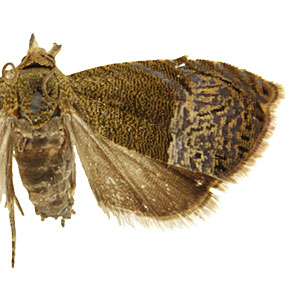Adult Recognition

FWL: 5.0-6.5 mm
Forewings are broadly triangular with a strongly arched costa, a row of black dots along the termen, and a conspicuous notch below the apex. The basal half of the wing is olive green while the apical half is extensively marked with metallic striations. Males lack a forewing costal fold.
The only other member of this genus, T. plummeriana, is recorded from the eastern half of the United States where it feeds on Asimina spp. (pawpaw); there are also unverified records of T. plummeriana from Mexico. The two species are similar in appearance but T. plummeriana is easily distinguished from T. batesi by the reddish color on the apical half of the forewing. Genitalia of the two species are quite different and a dissection can be used to confirm identity.
Larval Morphology

Last instar larvae are approximately 8-10 mm in length with a whitish abdomen. The head is yellowish brown and the prothoracic shield is brown to yellowish brown.
Talponia larvae can be distinguished by the large, single, brown pinaculum on A9 where the D1, D2, and SD1 setae are located. Other morphological features include: SV setal counts on A1,2,7,8,9 as 2:2:2:2:1 or 2:2:2:1:1; SD1 on A8 anterodorsal to spiracle; abdominal setae short; anal comb absent.
Biology

Females lay eggs on the flowers and fruits of Annona. Larvae bore into the fruit and feed inside until mature. Pupation occurs in leaves outside of the fruit. The number of generations per year is unknown although it is assumed that larval development is synchronized with fruit development.
Host plants
This species is a serious pest of Annona, and in Mexico crop losses on cherimoya range from 45-100% if larvae are not controlled. Talponia batesi is commonly intercepted at U.S. ports of entry on Annona originating from the Caribbean, Mexico, or Central America.
| Family | Genus/species | Common name |
| Annonaceae | Annona cherimola Mill. | cherimoya |
| Annonaceae | Annona glabra L. | pond apple |
| Annonaceae | Annona muricata L. | soursop |
| Annonaceae | Annona L. | custard apple |
Distribution

Talponia batesi has been recorded from the Caribbean, Mexico, and Central America. Larvae are commonly intercepted at U.S. ports of entry on Annona originating in Guatemala or Mexico.
References

Gomez, V. R. C. and J. V. Carrasco. 2008. Morphological characteristics of antennal sensilla in Talponia batesi (Lepidoptera: Tortricidae). Annals of the Entomological Society of America. 101: 181-188.
Heinrich, C. 1932. A new species infesting Annona (Lepidoptera: Olethreutidae). Proceedings of the Entomological Society of Washington. 34: 20-23.
MacKay, M. R. 1959. Larvae of the North American Olethreutidae (Lepidoptera). Canadian Entomologist Supplement 10: 1-338.

